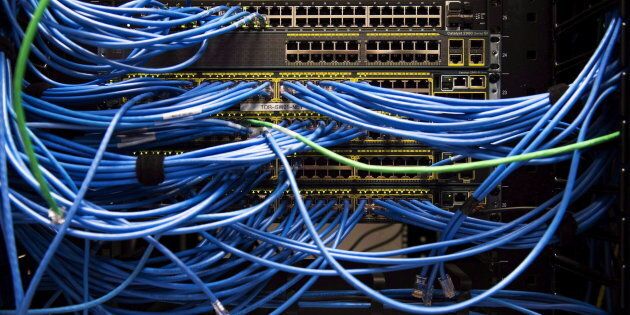
OTTAWA — Four years ago, the internet speed in the town of Assiniboia, Sask. doubled, allowing people to stream two simultaneous high definition videos on one connection.
Mayor Bob Himbeault believes the bump to 10 Mbps made an impact for local businesses. He's confident faster internet made a noticeable difference for home entertainment such as Netflix.
The federal government has pledged $1.7 billion over 13 years to establish a Universal Broadband Fund that will "focus on extending 'backbone' infrastructure to underserved communities."
Internet "backbones" are comparable to highways. They're necessary to build so rural, remote, and northern communities can access the internet at higher speeds.
Watch: What Canadians need to know about data-only cellular plans
The Liberals are hoping to win over voters living in an increasingly digital world with a pitch to introduce universal high-speed internet, at least 50/10 Mbps, to Canada's remote and northern communities by 2030.
Ninety per cent of Canadians are expected to have access to high-speed internet by 2021, according to the Canadian Radio-television and Telecommunications Commission (CRTC). That leaves a nine-year window to get the remaining 10 per cent, approximately 1.5 million households, connected to high-speed internet.
The pledge, which was unveiled in the federal budget, follows years of consultations and similar promises to get the vast country online. The government states up to $6 billion will need to be raised through a "coordinated plan" to bring in new investments to make the vision a reality.
New investments would come from partners including the provinces and territories, the CRTC, and the private sector.
Key details of Liberal plan 'missing'
The large sum of money is necessary to support the government's vision of an all-connected Canada by 2030, said Laura Tribe, executive director of Vancouver-based advocacy group Open Media.
"When you look around, what isn't connected to the internet at this point? It's so hard to see a world where you can justify giving some people access [to it] and others not."
She called the Liberal budget pitch a good start, but said more details are needed about where the government will find the remaining cash it needs to get the necessary infrastructure built.
To improve high-speed internet access in Canada's rural and remote regions, the government plans to secure "advanced Low Earth Orbit satellite capacity" — which is a significantly cheaper alternative to fibre optic.
A fibre-optic network would allow nearly unlimited download and upload speeds, but would cost between $40 billion-$50 billion, according to a 2016 estimate by Innovation, Science and Economic Development Canada. Using satellites to achieve a target internet speed of 50/10 Mbps, which the CRTC has stated as the baseline for what's considered high-speed access, would cost at least $6.5 billion, the department estimates.
Tribe says that since 11 years is a big window of time, the government needs to set a date for when different regions will get basic access to high-speed internet. Not doing so will leave communities behind by "picking and choosing" who's able to participate in contemporary society, she said.
"It's one thing to say this is how we think it will look like, but I think that there are a lot of details around what the implementation looks like, what the timeline looks like, who's coordinating the project that are still missing."
To get all of Canada online, the federal government is putting the $1.7 billion into a new "Universal Broadband Fund" which it says will "build on the success" of an earlier program.
"Connect to Innovate" was a $500-million program launched in 2016 with the goal to bring high-speed internet to 300 rural and remote communities across Canada within five years.
The federal program was the subject of one of the auditor general's fall reports where it was determined the department "did not implement the program in a way that ensured the maximum expansion for the public money spent."

Innovation, Science and Economic Development Canada, the department responsible for Connect to Innovate, "did not have a strategy to meet the connectivity needs of Canadians in rural and remote areas," the report stated.
The program also failed to give sufficient access to high-quality spectrum to smaller internet providers so they can improve broadband services to rural and remote communities.
There are few details on how the new Universal Broadband Fund differentiates from the Connect to Innovate program. The department did not respond to a request for additional information before publication.
Increasing broadband access to rural and remote communities has been on the government's radar for some time.
In January, Prime Minister Justin Trudeau promoted Nova Scotia MP Bernadette Jordan to a new cabinet position for rural economic development. Her mandate letter explicitly tasks her "to increase high-speed broadband coverage in rural Canada."
Slow internet has been the norm in British Columbia's Slocan Valley, but that will soon change with high-speed coverage planned for rollout later this year. The provincial government pledged in its 2019 budget to spend $50 million to expand high-speed internet to more than 200 communities.
More from HuffPost Canada:
Village of Silverton councillor Leah Main represents a community of just under 200 nestled on the eastern shore of Slocan Lake. The village needs reliable, affordable high-speed internet to attract young people and families and keep them from moving away.
Main told HuffPost Canada that in this digital age, having access to high-speed internet is critical for the survival of rural economies.
"With urban living becoming less and less affordable, we need to be able to offer young families a viable alternative, including supported opportunities for entrepreneurship," she said.
The government's 2018 budget earmarked $100 million over five years to develop Low Earth Orbit satellites to connect remote and northern communities. But the technology is prone to service interruptions, especially if you live in the north.
An overwhelming majority of Canada's northernmost communities in Inuit Nunangat, where the population is young with a median age of 23, do not have high-speed internet.
"To our knowledge, only one of the 51 Inuit communities in Inuit Nunangat has high-speed internet via fibre optic," an Inuit Tapiriit Kanatami spokeswoman told HuffPost in an email.
One graphic designer in Iqaluit told HuffPost Canada the northern city uses satellites to keep residents connected to the web. He spoke on the condition of anonymity because he was not authorized to speak publicly about how broadband satellite network affects the local business he works at. Blackouts are common, especially during blizzards or other wild weather events. Laying fibre optic would be the preferable choice, he said.